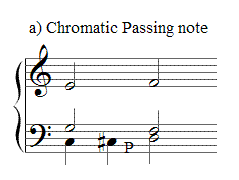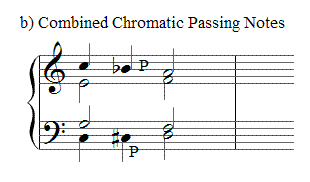APPENDIX A: VOICE LEADING OVERVIEW
The Chromatic Passing Note and Chromatic Passing Chord
Whereas in the strict counterpoint of the 16th century, only diatonic passing notes were allowed which filled in the gap of a third, in tonal music the chromatic passing note could be used which filled in the chromatic step between two notes a whole tone apart, as below, where the C# fills in between the C and D in the bass:

Just as more than one passing note can be combined in diatonic counterpoint, chromatic passing notes can be combined and these can be used to form new chords. If we add a further voice to the above descending from C via a chromatic Bb to A, we get the following:

The passing note here fills in a third but is nevertheless chromatic due to its alteration. These two chromatic passing notes form a diminished 7th chord in combination with the sustained G and E from the C major chord. This can be described as a chromatic passing chord. It arises totally out of voice leading, rather than as a result of a change of harmony. This is one of the most common uses of the diminished 7th chord.
As in other examples given, the voice leading elaborates on the underlying chord progression which is a C major chord moving to a D minor chord. Even when the voice leading produces whole chords - such as the diminished 7th chord here - if they arise out of voice leading they do not constitute root movements in themselves, they merely elaborate on the underlying chord progressions.
See Book Chapter 3 Part Three for more details on passing notes and passing chords.
See also the section on the double appoggiatura chord for a further example of a chromatic passing chord.
Next Topic: The Chromatic Auxiliary Note and the Chromatic Auxiliary Chord

